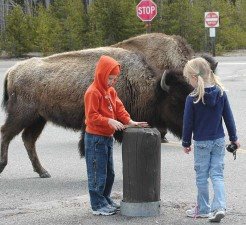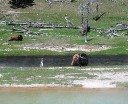Watch Yourself
P.S. - use ratty flies

<-- Island Park News Photo
-- There are dangers everywhere in Yellowstone National Park, & fly fishing brings visitors in contact with most of them. Normal dangers such as being run over by a car are always possible; especially with the visitation increasing.
-- Obvious dangers such as "habituated" wildlife are everywhere. Even bears and coyotes, and wolves are becoming habituated. These are things to keep in mind while fishing.
-- Other less common, but real dangers also exist. Sudden weather changes and the frequent thunderstorms pose a real danger. The disturbing thing about inclement weather is that fly fisherfolk know the danger, but the fishing is often "SOO GOOD!" And, it's often true that Baetis, and frequently Caddis pick grungy weather to erupt from the deep. But keep in mind that the current crop of graphite wands are probably better suited to be lightening rods!
-- Recently a fly fisherman was literally blown out of his shoes and severely injured by lightening. You can read about it in MainToday.com, and wonder that he's still alive. Another fly fisherman drowned in "Junction Pool" where the Beaverkill and Willowemoc come together. This famous pool was well known to the fisherman, as well as most serious fly fisherfolk. You can read about it HERE.

<-- Bison Guarding PMD Pool on the Firehole.
-- There are things to think about in Yellowstone that don't exist elsewhere. In addition to wildlife, automobiles, deep pools, thunderstorms, and back casting into traffic; there is the distinct possibility of dying in a hot spring, and being blinded by sulfurous eruptions.
-- Then there is the quicksand in places like Buffalo Ford, the confluence of the Firehole & Nez Perce, or the submerged hot springs in Pocket Basin.
-- Of course, typical hazards, such as the abrupt bench at 9-mile hole on the Madison, should also be mentioned. But then if you get in that far - you're wading where you should be fishing! This is often the case in the rivers and streams of Yellowstone. Much of the best holding water, & the best feeding lanes are in the shallow - sheltered bits of water near deep runs and pools. Often visitors walk right into a pile of fish and never know it.
-- In geological terms, these are young rivers, (some occupy ancestral channels - but still young,) and they exist in boisterous river beds. The gravels and boulders have not had time to be sorted into a uniform substrate. This provides diverse habitats and excellent fish production. It also provides surprises.
************************************
-- On a lighter note; there is merit in fishing "ratty" flies. A recent reprint in Mid Current, of an 'American Angler' article is a must read. Paul Schullery notes in the piece, that:
" The Magic of Ratty Flies
As something of a relief to novice fly tiers, ratty flies do work. It's not until we become accomplished at wrapping feathers and fur around hooks that we realize our ever-growing commitment to immaculate ties isn't necessarily helping us catching more fish. In fact, at least in the case of trout flies, it might even hurt our cause (emphasis - mine). On MidCurrent this week Paul Schullery shares his and other well-known authors' wisdom on the subject of less-than-impeccable flies. As he suggests in "The Mystery of the Ratty Fly," embracing the rat might be the smartest thing you do this season."-- Now it makes sense!
-- I don't catch fish because my flies are too good!!